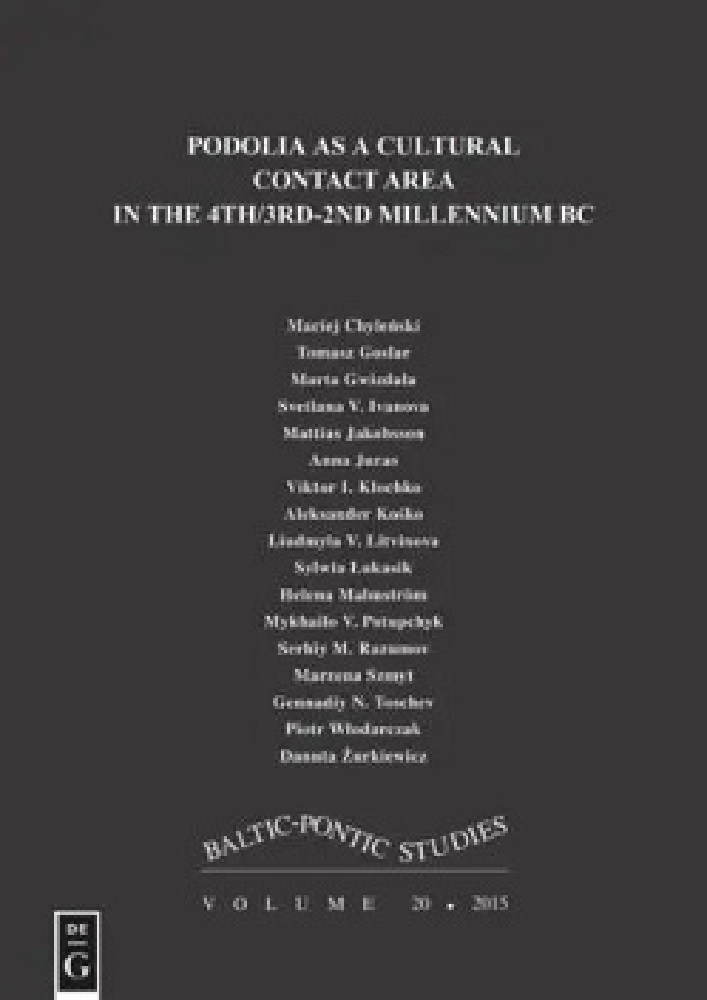Abstract
This study describes and discusses an old find from a wholly new perspective. The non-local fragment or fragments represent imports or imitations that can be linked to the Funnel Beaker culture and not to Kostolác, Coţofeni, Livezile or Bošáca as originally suggested by József Korek. The hallmarks distinctive to the culture are the ornamented rim exterior and rim interior, the zigzag motif under the rim and the ladder motif on the belly. However, the channelling on the belly is a typical Baden trait, which has not been noted on Funnel Beaker vessels to date. The best and closest analogies can be cited from the Baden settlement at Oldalfala/Stránska–Mogyorós, where they were erroneously identified as Coţofeni/Livezile imports. The occurrence of Funnel Beaker pottery on several sites on the southern fringes of the Western Carpathians suggests a more complex situation; however, their stratigraphic contexts on these multi-period, stratified sites remain unclear due to the field techniques employed during the old excavations. The determination of the exact place of origin is rather difficult within the culture’s vast distribution, although they can most likely be assigned to the Funnel Beaker eastern group, Wiórek phase (IIIB – IIIB-C in the current terminology), whose absolute dates fall between 3700/3600 and 3200 BC. The petrographic analyses revealed that the clay and the tempering agents are of local volcanic origin, providing conclusive evidence that Funnel Beaker vessels had been made locally. In this sense, the pottery fragment discussed here can be best described as a local hybrid product.
References
Balogh Z. 2015. Dornyay Béla, a salgótarjáni természetvédő. Neograd/Dornyay Béla Múzeum Évkönyve 38: 134-156.
Baráz Cs. 2002. Kaptárkövek a Bükkalján. In: Baráz Cs. (Ed.) A Bükki Nemzeti Park. Hegyek, erdők, emberek, 365-378. Eger.
Dornyay B. 1926. Salgótarján és vidéke őskorához. Salgótarján.
Dövényi Z. (Ed). 2010. Magyarország kistájainak katasztere. MTA Földrajztudományi Kutatóintézet, 810-817. Budapest.
Grygiel R. 2016. Neolit i początki epoki brązu w rejonie Brześcia Kujawskiego i Osłonek. Vol. III. Środkowy i późny neolit. Kultura pucharów lejkowatych / The Neolithic and Early Bronze Age in the Brześć Kujawski and Osłonki Region. Vol. III. Middle and Late Neolithic. The Funnel Beaker Culture. Łódź.
Gyalog L. (Ed.). 2005. Magyarázó Magyarország fedett földtani térképéhez (az egységek rövid leírása), 1:100 000. Magyar Állami Földtani Intézet. A Magyar Állami Földtani Intézet Térképmagyarázói. Budapest.
György L. 2014. Észak-Magyarország a késő rézkorban. A Baden-kultúra leletei Borsod-Abaúj-Zemplén megyében. Vol. 1. PhD Thesis. Budapest.
Hámor G. 1985. A Nógrád–Cserhát kutatási terület földtani viszonyai. Geologica Hungarica Series Geologica 22: 51.
Horváth G. 1991. A nógrádi bazaltvulkánosság. Földrajzi Értesítő 40: 339-346.
Horváth T. 2017. Salgótarján Pécs-kő: a nem(csak) badeni lelőhely. Neograd/Dornyay Béla Múzeum Évkönyve 40: 413-439.
Horváth T. 2018. Ózd csodálatos földje. A Baden-kultúra Ózd–Piliny variánsa Északkelet-Magyarországon/The Marvelous Land of Ózd. The Ózd–Piliny Variant of the Baden Culture in North-Eastern Hungary. Opitz Archaeologica 10. Budapest.
Horváth T., Svingor É. 2015. The spatial and chronological distribution of the so-called “Baden Culture”. In: M. Nowak, A. Zastawny (Eds) The Baden Culture around the Western Carpathians. Via Archaeologica – Special Edition, 19-75. Kraków.
Horváth T., Guba Sz., Bácsmegi G. 2017. Boleráz-Baden településrészlet Szurdokpüspöki Hosszú-dűlő lelőhelyen (Nógrád megye, Magyarország). Neograd/Dornyay Béla Múzeum Évkönyve 40: 372-413.
Horváth T., Guba Sz., Bácsmegi G. 2018. Siedlungsteil der Boleráz- und der Badener Kultur aus Szurdokpüspöki-Hosszú-dűlő (Kom. Nógrád, Ungarn). Ziridava Studia Archaeologica 32: 7-40.
Horváthová E., Nevizánsky G. 2017. Stránska. Osada Badenskej kultúry z obdobia eneolitu v kontexte vývoja severného potisia. Archaeologica Slovaca Monographiae. Studia Archaeologici Nitriensis Academiae Scientiarum Slovacae 28. Bratislava– Nitra.
Jugovics L. 1942. Salgótarján és Bárna környékén előforduló bazaltok és bazalttufák. A Magyar Királyi Földtani Intézet évi jelentése az 1936-38. évekről 2: 957-969.
Jugovics L. 1971. Észak-magyarországi-Salgótarján környéki-bazaltterületek. A Magyar Állami Földtani Intézet évi jelentése az 1968. évről: 145-165.
Juhász Á. 1987. Évmilliók emlékei: Magyarország földtörténete és ásványi kincsei, 113-114, 423, 436-438. Budapest.
Korek J. 1968. Eine Siedlung der Spätbadener Kultur in Salgótarján-Pécskő. Acta Archaeologica Scientiarum Hungaricae 20: 37-58.
Kośko A. 2006. Ceramika kultury pucharów lejkowatych. In: A. Kośko, M. Szmyt, Opatowice–Wzgórze Prokopiaka. Vol. I. Studia i materiały do badań nad późnym neolitem Wysoczyzny Kujawskiej I, 139-194. Poznań.
Kośko A., Przybył A. 2004. Kultura pucharów lejkowatych. In: J. Bednarczyk, A. Kośko (Eds) Od długiego domu najstarszych rolników do dworu staropolskiego. Wyniki badań archeologicznych na trasach gazociągów Mogilno-Włocławek i Mogilno-Wydartowo, 235-314. Poznań.
B. Kovács I. 1986. A Rima-medence az újkőkorban és a rézkorban. PhD Thesis. Budapest.
Kruk J., Lityńska-Zając M., Milisauskas S. 2016. Gospodarka roślinna w neolicie. Studium przypadku – Bronocice. Kraków.
Malček R. 2016. Badenské osídlenie Cerovej vrchoviny. Archaeologica Slovaca Monographiae. Fontes Instituti Archaeologici Academiae Scientiarum Slovacae 21. Nitra.
Nowak M. 2017. Ubiquitous settlers, consequent farmers, and monument builders. In: P. Urbańczyk, P. Włodarczak (Eds) The Past Societies. Polish Lands from the first Evidence of Human Presence to the Early Middle Ages. Vol. II. 5500 – 2000 BC, 125-170. Warszawa.
Patay P. 1999. A Badeni kultúra Ózd-Pilinyi csoportjának magaslati telepei (Höhensiedlungen der Spätbadener Ózd-Piliny Gruppe). Herman Ottó Múzeum Évkönyve 37: 45-56.
PCRG. 2010. The study of later prehistoric pottery: general policies and guidelines for analysis and publication. Prehistoric Ceramic Research Group: Occasional Papers Nos 1 and 2. 3rd edition revised.
Prakfalvi P. (Ed.). 1999. Magyarország földtani térképe 1:100 000. M-34-136: Salgótarján. Magyar Állami Földtani Intézet. Budapest.
Prakfalvi P. 2018. A Pécs-kő és a Hurka-Pécs-kő kőbányászata. A Pécskői Bazaltbánya Rt. története 1923-1941. Salgótarján környéki bazaltbányászat 1. Salgótarján.
Rzepecki S. 2015. Wilkostowo 23/24. A Neolithic Settlement in Kuyavia, Poland c. 3500 BC. Studien zur Archäologie in Ostmitteleuropa / Studia nad Pradziejami Europy Środkowej 15. Kraków – Bonn.
Włodarczak P. 2006. Chronologia grupy południowo-wschodniej kultury pucharów lejkowatych w świetle dat radiowęglowych. In: J. Libera, K. Tunia (Eds) Idea megalityczna w obrządku pogrzebowym kultury pucharów lejkowatych, 27-66. Lublin – Kraków.
License
Copyright (c) 2020 Tünde Horváth, Attila Kreiter, Orsolya Viktorik

This work is licensed under a Creative Commons Attribution-NonCommercial-NoDerivatives 3.0 Unported License.





